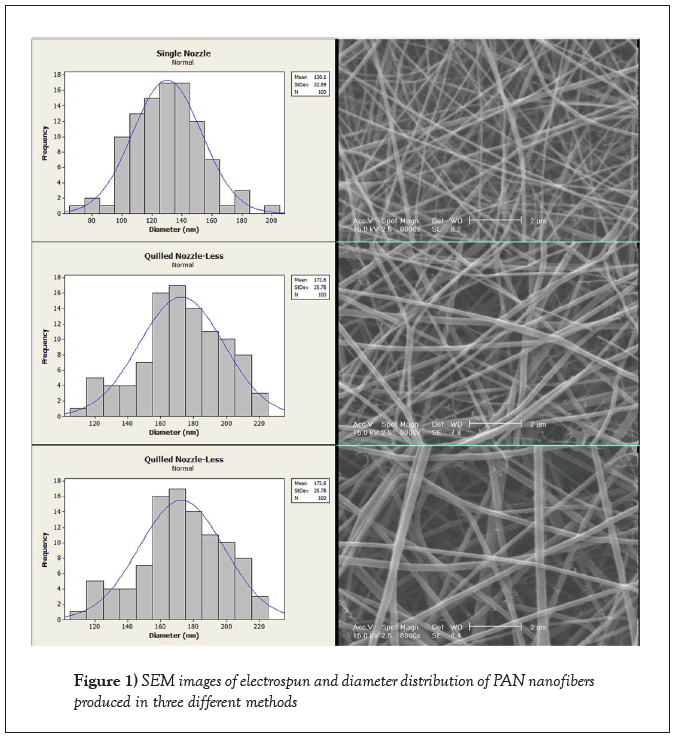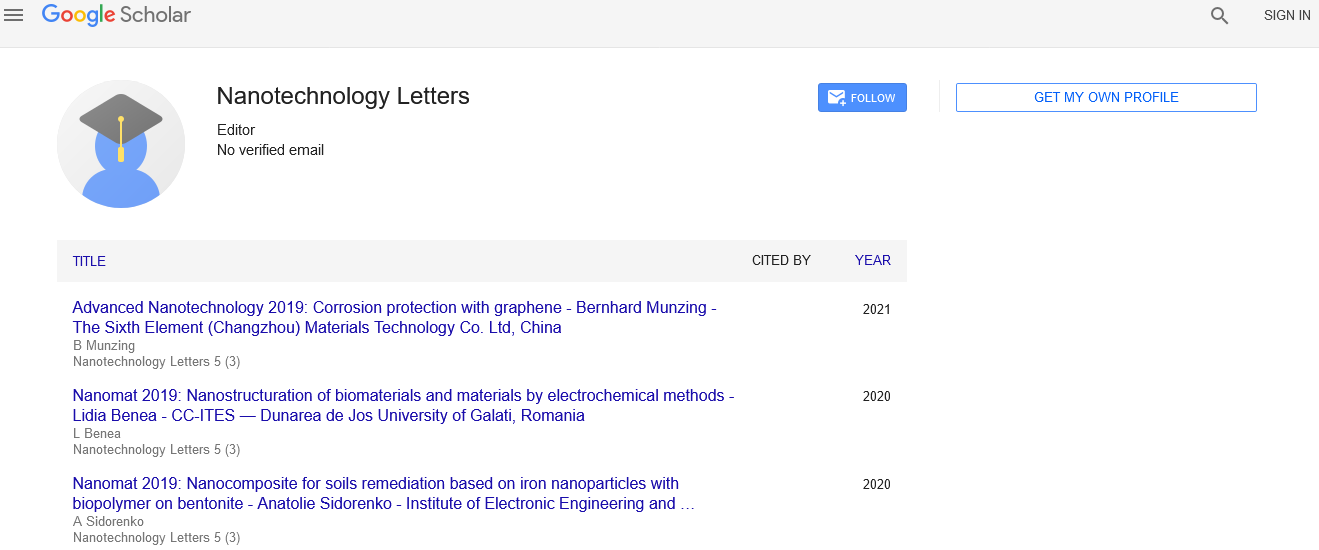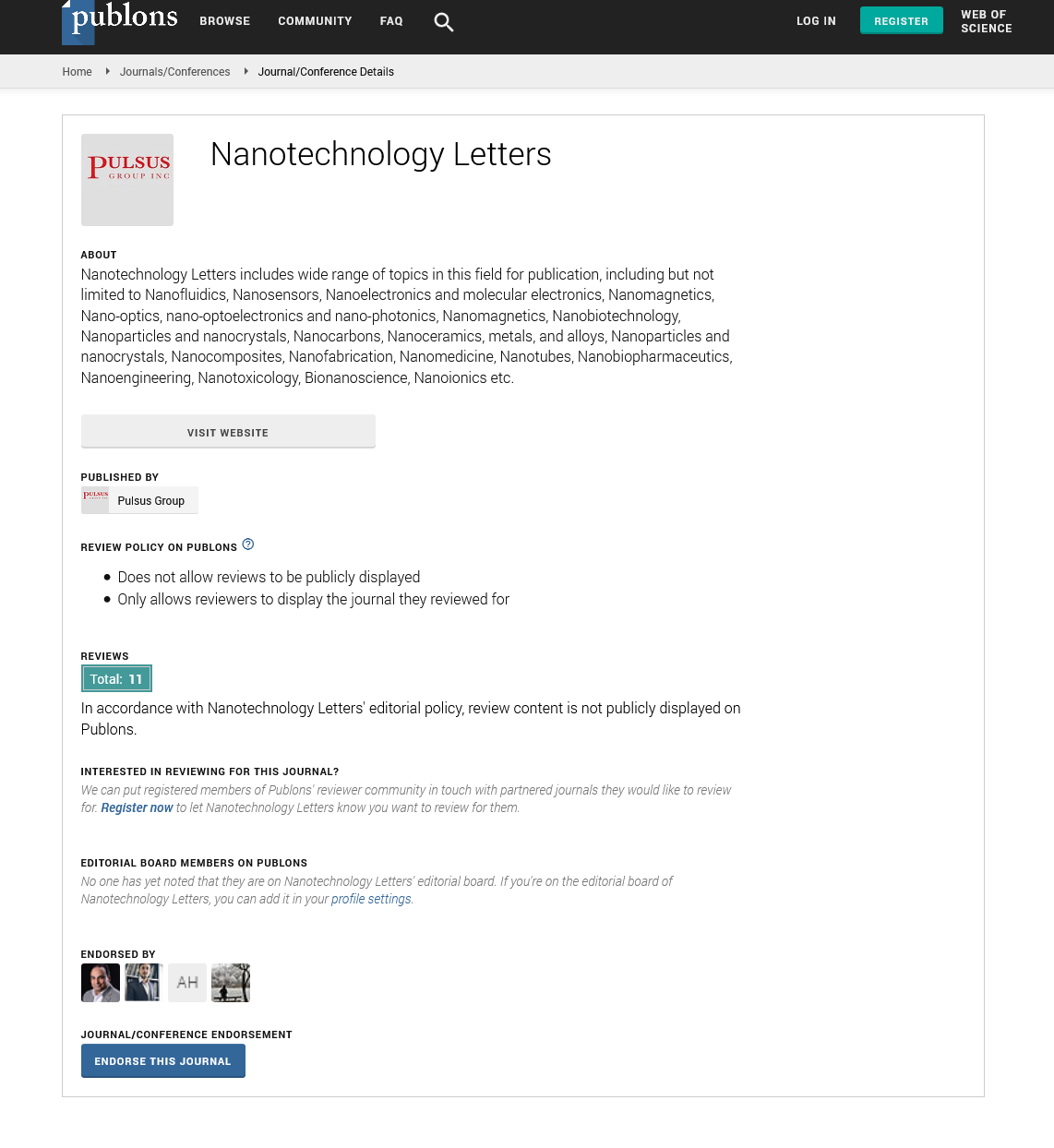An innovative concept in manufacture of PAN nano fibres
Received: 01-Oct-2021 Accepted Date: Oct 15, 2021; Published: 22-Oct-2021
Citation: Gokarneshan N, Rashmikaa S, Varsha M, et al. An innovative concept in manufacture of PAN nano fibres. Nanotechnol Lett. 2021;6(2):1-3.
This open-access article is distributed under the terms of the Creative Commons Attribution Non-Commercial License (CC BY-NC) (http://creativecommons.org/licenses/by-nc/4.0/), which permits reuse, distribution and reproduction of the article, provided that the original work is properly cited and the reuse is restricted to noncommercial purposes. For commercial reuse, contact reprints@pulsus.com
Abstract
Over the last decades by appearing nanotechnology electrospinning has been reconsidere as a significant method. However, electrospinning production rate is limited by the rate at which the polymer solution or melt is fed to a single jet. Feeding rate can be increased through implementing a wide range of methods such as multiple nozzle electrospinning. In the present work, an innovative “quilled” drum with a peculiar design was rotated in a PAN polymer solution in an electrical field to optimize energy consumption, uniform nanofiber distribution on the collector, and increase production rate. The produced nanofibers were compared with those produced from modified multi-nozzle and single-nozzle electrospinning methods. The mean diameters of nanofibers produced from the quilled drum was 32% greater than that of single-nozzle and 28% less than multi-nozzle electrospinning. The CV% of thickness of the webs were 7.9%, 11.2%, and 12.5% for the quilled, single nozzle and multi-nozzle methods, respectively which showed the presented method produced more uniform webs. The production rate of this electrospinning was 60 and 17 times more than single and multi-nozzle methods, respectively.
Keywords
Electrospinning, Nozzle-less, Nanofibers, Producing method, Polyacrylonitrile
Introduction
Nanofibers are of great importance due to their high surface to volume ratio, porosity, and good mechanical performance in a wide variety of applications [1]. They are used in vast areas such as tissue engineering, wound dressing, drug delivery systems, filtration, and self-cleaning surfaces [2-7]. There are different methods for producing nanofibers such as drawing, template synthesis, phase separation, self-assembling, and electrospinning [8,9]. In comparison with electrospinning, other methods can produce limited amount of nanofibers. In addition, these methods have more disadvantages. Drawing is a discrete method, self-assembling is complicated, phase separation is limited to special polymers, and template synthesis has fiber diameter limit [10]. On the other hand, electrospinning is widely used due to its cost effectiveness, simplicity, flexibility, and ability to use various range of polymers [11-13].
Over the last decades by appearing nanotechnology electro spinning has been reconsidered as a significant method. However, electro spinning production rate is limited by the rate at which the polymer solution or melt is fed to a single jet [14,15]. There are various methods to increase the production rate such as multiple nozzle electro spinning in which nanofibers with different polymer compositions can be produced [16]. Nevertheless, utilizing multiple jets significantly increases the costs. Moreover, since the jet distribution is made artificially, the process has instabilities and the production of nano fiber layers is not homogenous [17]. Another economical method to increase the production rate is nozzle-less electrospinning which can be used for nanofiber mass production [18]. One of the most productive types of the above mentioned method is free liquid surface electro spinning in which the number and location of the jets are set up naturally in their optimal positions [19].
A two-layer system has been proposed in which the lower layer was a ferromagnetic suspension and the upper layer was a polymer solution. The layers were subjected to a normal magnetic field provided by a permanent magnet or a coil. Thus, multiple electrified jets were exposed to strong stretching by the electric field and bending instability. Finally, solvent evaporated and solidified nanofibers deposited on the upper counter- electrode, as in an ordinary electrospinning process [20].
Air pressure has been applied through the walls of a porous polyethylene tube to form multiple jets for electrospinning nylon 6 nanofibers from a 20 wt % solution. The fibers had a similar mean diameter to those produced from a single nozzle method in spite of broader distribution. Their mass production rate was 250 times greater than that of a typical single nozzle method [21]. A tube having a porous wall to electrospin polyvinylpyrrolidone has also been used (PVP) from a polymer solution of 15 wt% by the help of low air pressure of 1-2 kPa through the tube wall. They used an electric field of 40-60 kV. They showed that from a 13 cm long tube with 20 holes, 0.3-0.5 g/h of nanofiber could be produced [22]. The jetting from free liquid surface has been observed, analyzed, and compared on specially designed linear cleft electrospinner with the theoretical predictions and obtained satisfactory results [23]. A simple unique needleless method has been used. Charged vertically oriented threaded rods have been adopted for holding multiple drops to launch many simultaneous jets. Tests have been conducted with a single or multiple rods arranged in a linear array. It has been shown that a single rod of about 50 cm in length could produce PVP fibers at a rate of 4.5 g/h and 200-400 nm size range [24].
A needleless electrospinning setup named “Needleless Twisted Wire Electrospinning” has been developed. PVP, Hydroxy-Apatite (HA) and bioglass to electrospin nanofibers has been used from a surface of a twisted wire set to a high voltage. The production rates for PVP and HA were 5.23 and 1.40 g/h, respectively [25].
In this work, a method of electrospinning is presented to optimize energy consumption and uniform nanofiber distribution on the collector which leads to more even thickness of the derived mat through the width. Thus, an innovative “quilled” drum with a peculiar design was rotated in a polymer solution in an electrical field. The produced nanofibers were compared with those produced from multi-nozzle and single-nozzle electrospinning methods.
Literature Review
SEM studies
Figure 1 shows diameter distribution and SEM images of electrospun PAN nanofibers and Table 1 reports their mean diameter and production rate in the three setups. The mean diameters of nanofibers produced from setups B and C were 84 and 32% greater than that of setup A, respectively.
| Electrospinning type | Mean diameter | Standard deviation of diameter (nm) | Production rate (gms/hr) |
|---|---|---|---|
| Single nozzle | 130 | 22.99 | 0.12 |
| Multi nozzle | 239 | 34.22 | 0.43 |
| Quilled nozzleless | 171 | 24.56 | 7.2 |
Table 1: Mean diameter and production rate of various electrospinning set up
The production rate of the presented method was drastically greater than those of setups A and B. In this method, in the optimum rpm of 5 and according to the special arrangement of the quills, there was a potential of forming 28 jets in each rotation. The jets were formed naturally on the apex of the quills and thus the optimized paths were selected by them in three different methods.
Therefore, the jets were free to be deposited from the randomly determined positions to the collector drum and the production rate was increased. Moreover, in this method all the jets can be supplied by a single power supply with less voltage in comparison with other methods due to the absence of syringe pump and consequently the simplicity of jet forming.
Table 2 reports the thickness in 30 different randomly selected points of the electrospun webs. It should be noted that the weights of the webs were normalized based on time. Thus, for evaluating webs uniformity the thickness of each nanofibrous web produced in different time was measured. The thickness of PAN web in setup C was more uniform in comparison with setups A and B.
| Electrospinning type | Thickness (µm) | Standard deviation | CV% |
|---|---|---|---|
| Single nozzle | 35 | 3.94 | 11.2 |
| Multi nozzle | 46 | 6.72 | 12.5 |
| Quilled nozzleless | 79 | 6.47 | 7.9 |
Table 2: Thickness of PAN Nano fibre mats
In a multiple-nozzle electrospinning, in addition to the external electric field and selfinduced coulombic interactions which influence the jet path, mutual-coulombic interactions between different jets are also effective. Thus, a decrease in the distance between every two nozzles results in greater repulsion between the jets. In addition, decreasing the inter-nozzle distance leads the onset of the electrically driven bending instability, which is the main factor for reducing the fiber diameter to the nanometer scale, to delay. For compensating this delay, the distance between needle and collector should be increased. However, the distance between the collector and the needle is limited, the above mentioned delay can be requited by increasing the inter-needle distance.
The quills were arranged in a way that in each rotation only one row of the quills was responsible for generating jets. Thus, there was no perturbation between the electric field of each row. Moreover, each quill was 40 mm away from the adjacent one and hence the interactions between the jets were reduced. On the other hand, the arrangement of the quills was in a way that each one could deposit polymer solution to the collector drum in even distances which led to a more uniform web formation as appose to multinozzle method. Unlike the stripes which were formed in the latter method, in the presented electro spinning no stripes were observed.
Discussion and Conclusion
In the present work a new method of electrospinning was introduced by floating a quilled drum in PAN solution. The production rate of the presented method was drastically greater than those of single and multiple-nozzle methods. The quills were arranged in a way that in each rotation only one row of the quills was responsible for generating jets. Thus, there was no perturbation between the electric field of each row. Moreover, the interactions between the jets were reduced by imposing a sufficient distance between them. Having the potential of forming 28 jets on the apex of the quills in each rotation, the jets were free to be deposited from the randomly determined positions to the collector drum and the production rate was increased. The arrangement of the quills was in a way that each one could deposit polymer solution to the collector drum in even distances which led to a more uniform web formation as appose to multi-nozzle method.
REFERENCES
- Ciera LW. Incorporation of bioactive materials in nanofibers during electrospinning. 2011.
- Semnani D, Naghashzargar E, Hadjianfar M, et al. Evaluation of PCL/chitosan electrospun nanofibers for liver tissue engineering. Int J Polym Mater. 2017;66(3):149-157.
- Vargas ET, do Vale Baracho NC, De Brito J, et al. Hyperbranched polyglycerol electrospun nanofibers for wound dressing applications. Acta Biomater. 2010;6(3):1069-1078.
- Hu X, Liu S, Zhou G, et al. Electrospinning of polymeric nanofibers for drug delivery applications. J Control Release. 2014;185:12-21.
- Zamani M, Morshed M, Varshosaz J, et al. Controlled release of metronidazole benzoate from poly ε-caprolactone electrospun nanofibers for periodontal diseases. Eur J Pharm Biopharm. 2010;75(2):179-185.
- Su S, Li JL, Zhou L, et al. Ultra-thin electro-spun PAN nanofiber membrane for high-efficient inhalable PM2.5 particles filtration. In: Journal of Nano Research 2017. Trans Tech Publications Ltd, pp. 73-81.
- Huang QL, Huang Y, Xiao CF, et al. Electrospun ultrafine fibrous PTFE-supported ZnO porous membrane with self-cleaning function for vacuum membrane distillation. J Membr Sci. 2017;534:73-82.
- Yoon YI, Moon HS, Lyoo WS, et al. Superhydrophobicity of cellulose triacetate fibrous mats produced by electrospinning and plasma treatment. Carbohydr Polym. 2009;75(2):246-250.
- Zhang YZ, Venugopal J, Huang ZM, et al. Characterization of the surface biocompatibility of the electrospun PCL-collagen nanofibers using fibroblasts. Bio Macro Mol. 2005;6(5):2583-2589.
- Caruso RA, Schattka JH, Greiner A. Titanium dioxide tubes from sol–gel coating of electrospun polymer fibers. Adv Mater. 2001;13(20):1577-1579.
- Hu X, Liu S, Zhou G, et al. Electrospinning of polymeric nanofibers for drug delivery applications. J Control Release. 2014;185:12-21.
- Ramakrishna S. An introduction to electrospinning and nanofibers. World scientific. 2005.
- Semnani D, Naghashzargar E, Hadjianfar M, et al. Evaluation of PCL/chitosan electrospun nanofibers for liver tissue engineering. Int J Polym Mater. 2017;66(3):149-157.
- Li D, Xia Y. Electrospinning of nanofibers: Reinventing the wheel?. Adv Mater. 2004;16(14):1151-1170.
- Theron SA, Yarin AL, Zussman E, et al. Multiple jets in electrospinning: experiment and modeling. Polymer. 2005;46(9):2889-2899.
- Theron SA, Zussman E, Yarin AL. Experimental investigation of the governing parameters in the electrospinning of polymer solutions. Polymer. 2004;45(6):2017-2030.
- Petrik S, Maly M. Production nozzle-less electrospinning nanofiber technology. MRS Online Proceedings Library (OPL). 2009;1240.
- Rafiei S, Maghsoodloo S, Noroozi B, et al. Mathematical modeling in electrospinning process of nanofibers: A detailed review. Cellul Chem Technol. 2013;47(5):323-38.
- Yarin AL, Zussman E. Upward needleless electrospinning of multiple nanofibers. Polymer. 2004;45(9):2977-80.
- Dosunmu OO, Chase GG, Kataphinan W et al. Electrospinning of polymer nanofibres from multiple jets on a porous tubular surface. Nan Tech. 2006;17(4):1123-1127.
- Varabhas JS, Chase GG, Reneker DH. Electrospun nanofibers from a porous hollow tube. Polymer. 2008;49(19):4226-4229.
- Lukas D, Sarkar A, Pokorny P. Self-organization of jets in electrospinning from free liquid surface: A generalized approach. J Appl Phys. 2008;103(8):084309.
- Shin HU, Li Y, Paynter A, Nartetamrongsutt K, et al. Vertical rod method for electrospinning polymer fibers. Polymer. 2015;65:26-33.
- Holopainen J, Penttinen T, Santala E, et al. Needleless electrospinning with twisted wire spinneret. Nano Tech. 2014;26(2):025301.
- Tehrani SP, Hadjianfar M, Afrashi M, et al. An investigation on quilled nozzle-less electrospinning in comparison with conventional methods for producing PAN nanofibers. Fashion and Textiles. 2018;5(1):1-8.







